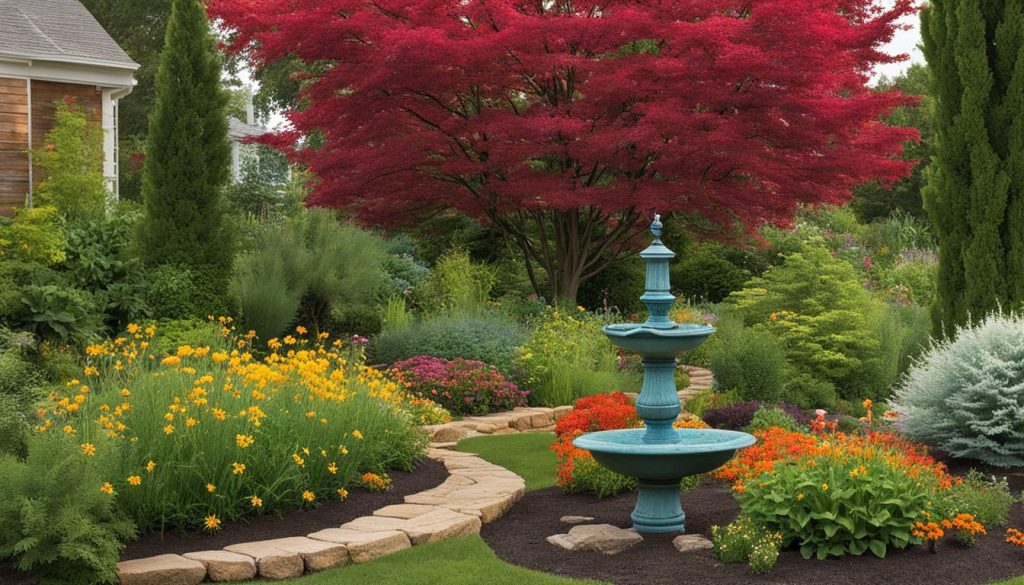Welcome to our guide on wildlife-friendly landscaping! In this section, we’ll show you how to create a beautiful yard that not only looks great but also supports local wildlife. With a few simple steps, you can provide a safe and welcoming environment for birds, bees, butterflies, and other creatures.
Creating a habitat in your yard is not only good for wildlife but also beneficial for you. It’s a great way to connect with nature and can improve your mental health and well-being. Plus, it’s a fun and rewarding activity that the whole family can enjoy!
Key Takeaways
- Wildlife-friendly landscaping is a great way to support local species and create a beautiful yard.
- Creating a habitat in your yard provides numerous benefits for both wildlife and humans.
- With careful planning, you can design a space that maximizes its effectiveness as a wildlife habitat.
- Native plants are crucial for creating a successful wildlife habitat.
- Providing food, water, and shelter are key components of wildlife-friendly landscaping.
The Benefits of Wildlife-Friendly Landscaping
At first glance, creating a wildlife-friendly landscape may seem like a daunting task, but the rewards are well worth the effort. By choosing to implement this approach in your yard, you will not only help support biodiversity in your local environment but also reap numerous benefits yourself.
Environmental Benefits
One of the main advantages of wildlife-friendly landscaping is the positive impact it has on the environment. By creating a habitat for local species, you are helping to preserve and restore the natural balance of your local ecosystem. Some of the environmental benefits of this approach include:
| Benefits | Explanation |
|---|---|
| Supporting Biodiversity | By providing native plants and other suitable habitats, you can help ensure the survival of wildlife species that are native to Canada. |
| Reducing Water Usage | Many native plants require less water than non-native species, which can lead to significant water savings over time. |
| Improving Soil Health | Native plants help improve soil quality by promoting healthy soil microorganisms and reducing erosion. |
| Protecting Natural Resources | Wildlife-friendly landscaping helps protect natural resources such as air, water, and soil by creating a healthy and sustainable local environment. |
Personal Benefits
Along with the environmental benefits, wildlife-friendly landscaping can also offer a multitude of personal benefits. Here are just a few:
- Enjoyment of observing wildlife in your own backyard.
- Opportunities for outdoor recreation and relaxation.
- Increased property value and curb appeal.
- Lower long-term maintenance costs.
- Enhanced aesthetic appeal and beauty of the yard.
Overall, creating a wildlife-friendly landscape is a rewarding and worthwhile endeavor that benefits both you and the environment. By taking the time to plan and implement this approach, you can enjoy a beautiful and thriving yard while also making a positive impact on the world around you.
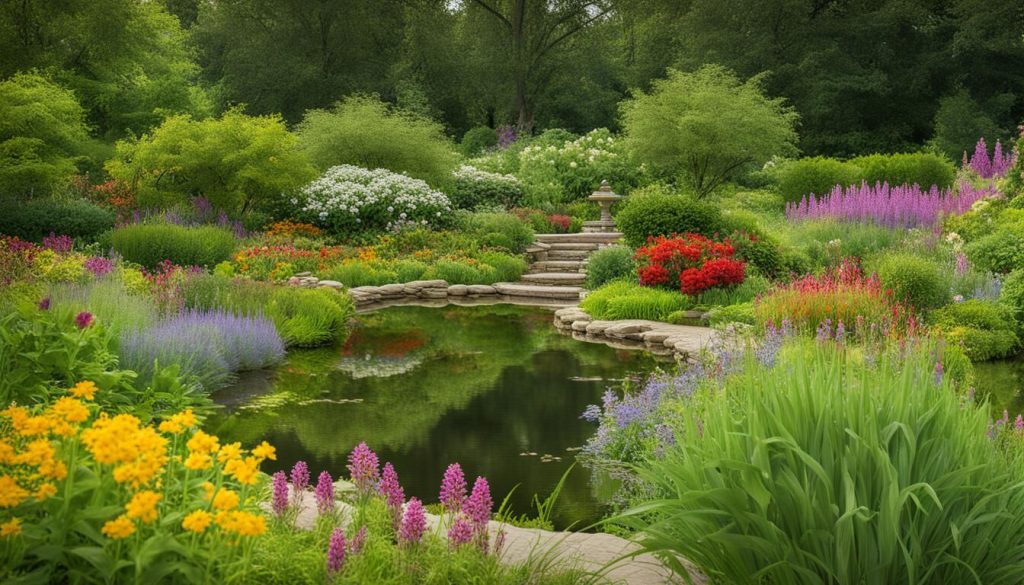
Planning Your Wildlife-Friendly Garden
Before we start digging in, let’s take a moment to plan our wildlife-friendly garden. A well-planned garden can help attract and support local wildlife, providing them with everything they need to thrive.
Consider Your Space: Start by assessing the size and shape of your yard, and how you want to use it. Are there any areas that are particularly sunny or shady? Are there spots with poor drainage? These factors will help you decide where to place specific plants or features.
Research Your Region: Understanding the climate and habitat of your region will help you choose the right plants and materials for your garden. Research the native species in your area and how they interact with local wildlife.
Creating Zones
Creating zones within your garden can help maximize its effectiveness as a wildlife habitat. Think of your garden as a mini-ecosystem, with different zones to provide food, water, shelter, and nesting opportunities for different creatures. Here are some examples of zones you might consider:
- Food Zone: This zone can include plants that provide nectar, berries, or seeds, as well as bird feeders, and compost piles.
- Water Zone: Incorporate water features such as bird baths, ponds, or rain gardens to offer a steady supply of fresh drinking water for wildlife.
- Shelter Zone: This zone can include trees, shrubs, and brush piles to provide shelter and cover for local species.
- Nesting Zone: Create zones that offer safe spaces for wildlife to build nests or dens, such as birdhouses, bat boxes, or rock piles.
Designing Your Garden
When designing your garden, keep in mind the needs of the wildlife you hope to attract. Here are some tips:
- Include a variety of plant heights and types to support different species and their unique habitat requirements.
- Use native plants whenever possible, as they are adapted to your region and provide the best resources for local wildlife.
- Consider using organic gardening methods to avoid harmful chemicals and pesticides that can harm both wildlife and the environment.
- Choose plants that bloom at different times to offer a continuous supply of food and nectar throughout the growing season.
With careful planning and design, your garden can become a thriving habitat for local wildlife. So grab your gardening gloves and let’s get started!
Native Plants: The Foundation of Wildlife Habitat
Native plants are crucial for creating and maintaining a thriving wildlife habitat in your yard. These plants have evolved over time to fit the specific needs of local wildlife, providing essential food, shelter, and nesting spaces. Additionally, native plants require less maintenance and are more resistant to pests and diseases, making them an eco-friendly and sustainable landscaping choice.
Benefits of Native Plants
The benefits of native plants extend far beyond their role as the foundation of a wildlife habitat. They also:
- Require less water and fertilizer than non-native plants
- Improve soil health and prevent erosion
- Provide important ecosystem services, such as pollination and carbon sequestration
- Restore and maintain biodiversity in local ecosystems
Choosing the Right Plants
When selecting native plants for your yard, it’s important to consider factors such as soil type, sun exposure, and moisture levels. Consulting with a local gardening expert or doing research on native species in your area can be helpful in making these choices.
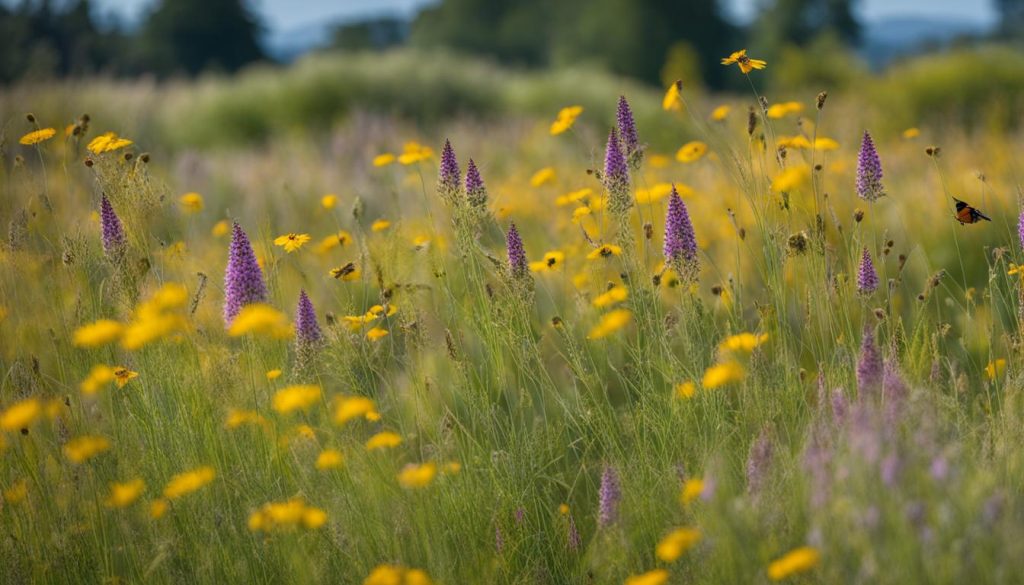
Some popular native plant species in Canada include:
| Plant | Light Requirements | Soil Type |
|---|---|---|
| Wild Lupine | Full sun | Sandy, well-drained |
| Wild Columbine | Partial shade | Moist, well-drained |
| Purple Coneflower | Full sun to part shade | Well-drained |
Remember, using native plants in your yard helps to establish a thriving habitat for local wildlife, supports the health of local ecosystems, and reduces maintenance and water usage. Incorporating native plants is a simple and effective way to create a beautiful and sustainable landscape.
Providing Food and Water Sources
Incorporating food and water sources is a crucial aspect of creating a thriving wildlife habitat in your yard. By providing these basic necessities, you can attract a variety of species and support their survival.
Food Sources
When it comes to selecting plants for your yard, consider those that produce fruits, seeds, or nectar, as they will provide a natural food source for local wildlife. Additionally, you may want to consider including a bird feeder to attract various bird species, such as chickadees, finches, and woodpeckers. Be sure to clean and refill feeders regularly to prevent the spread of disease and ensure a consistent food supply.
Table: Popular Food Sources for Wildlife in Canada
| Species | Food Source |
|---|---|
| Birds | Seeds, fruits, nectar, suet, insects |
| Squirrels | Nuts, seeds, fruits |
| Butterflies | Nectar from flowers |
| Bees | Nectar and pollen from flowers |
Water Sources
Water is essential for all living creatures, including wildlife. You can provide water in your yard by incorporating a bird bath, pond, or small fountain. Ensure that the water source is shallow enough for small animals to use safely and change the water regularly to prevent the growth of bacteria and mosquitoes. You can also consider installing a drip system to provide a consistent water source for plants and animals alike.
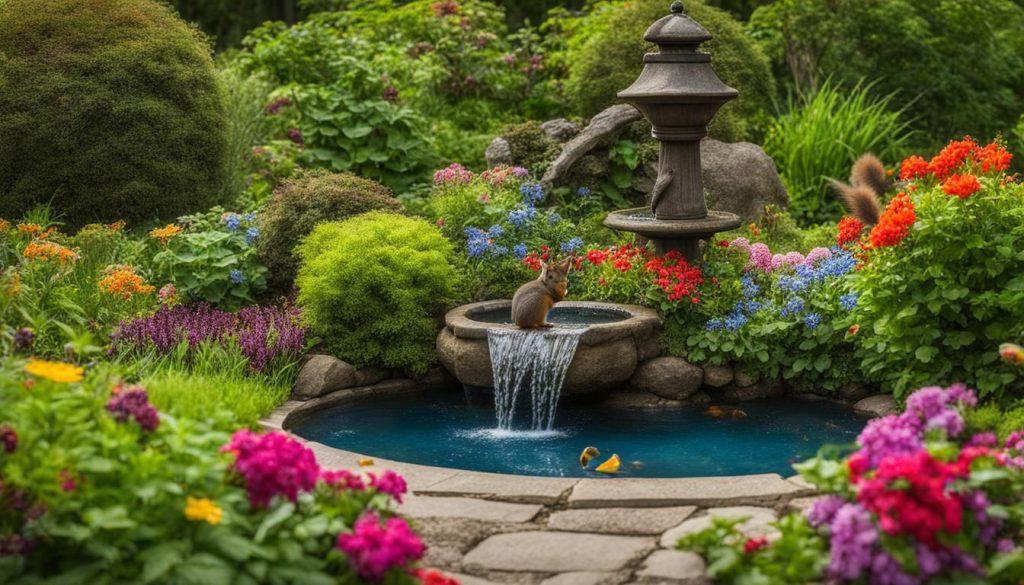
By incorporating both food and water sources, you can create a habitat that will support a variety of species throughout the year. Take the time to research the specific needs and preferences of wildlife in your area to ensure that your efforts are effective and sustainable.
Creating Shelter and Nesting Spaces
Creating inviting shelter and nesting spaces is essential to attract and support wildlife in your yard. Different species have unique needs for shelter, so it’s crucial to incorporate a variety of habitats to accommodate a diverse range of local wildlife.
Building Nest Boxes
Nest boxes provide safe and secure spaces for birds to lay their eggs and raise their young. You can purchase pre-made nest boxes or build your own using natural materials.
When constructing a nest box, it’s important to consider the size and shape requirements for the bird species you want to attract. The entrance hole should be the appropriate diameter for the target species and positioned high enough to deter predators.
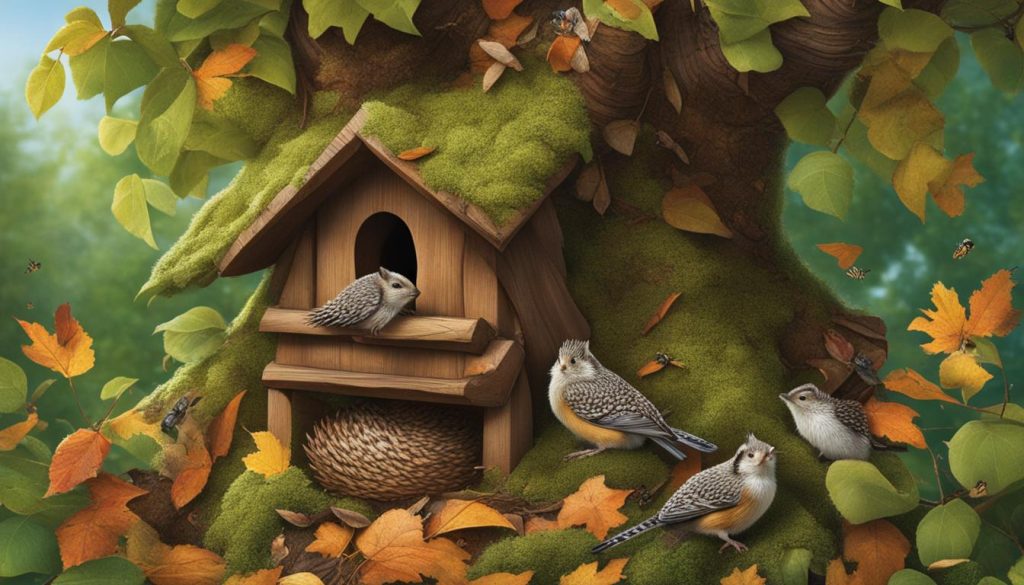
Designing Brush Piles
Brush piles are an excellent way to create shelter for small mammals, reptiles, and amphibians. These piles can be made using twigs, branches, and other natural debris in a secluded area of your yard.
As the brush pile decomposes, it becomes an ideal habitat for insects, which in turn attract birds and other animals that feed on them. Avoid using non-native materials or treated wood, which can be harmful to wildlife.
Planting Trees and Shrubs
Trees and shrubs provide a variety of benefits to wildlife, including shelter, nesting sites, and food sources. When selecting trees and shrubs, choose native species that are best suited for your region.
Consider the specific needs of the wildlife you want to attract. For example, some species of bats prefer dense, bushy shrubs for roosting, while others require tall trees with large cavities for nesting.
Creating a Rock Pile
Rock piles provide shelter for a variety of reptiles and insects. They can be made using rocks of various sizes and placed in a sunny area of your yard.
The rocks should be arranged in a way that creates small crevices and spaces for animals to hide and nest. In addition to offering shelter, rock piles also provide a warm basking spot for cold-blooded creatures like snakes and lizards.
By incorporating these shelter and nesting spaces into your wildlife-friendly landscape, you can create a thriving habitat for local species. Remember to maintain these features regularly to ensure they remain safe and functional for wildlife.
Coexisting with Wildlife
Living in an environment where people and wildlife coexist can present challenges, but it can also be an opportunity to appreciate the beauty and diversity of the natural world. To ensure a harmonious relationship, we must understand and respect the needs and behaviors of the wildlife that share our communities.
Here are some tips for peacefully coexisting with wildlife:
- Do not feed wildlife: Providing food for wildlife can end up doing more harm than good. Wild animals are perfectly capable of finding their own food, and feeding them can lead to dependency, habituation, and health problems. It can also make them more vulnerable to predators and can attract unwanted animals to your yard.
- Secure your garbage: Garbage is a common attractant for wildlife, so it’s important to keep it secure. Use animal-proof containers and secure lids to keep wildlife out of your garbage. Store garbage in a secure location until collection day to reduce the chances of animals getting into it.
- Keep pets under control: Make sure your pets are under control at all times, whether indoors or outdoors. Pets can pose a threat to wildlife and can be injured in encounters. Keep your cat indoors, and always keep your dog on a leash when outside. Avoid walking your dog in areas where you know wildlife is present.
- Prevent wildlife from entering your home: Make sure your home is wildlife-proofed to prevent animals from getting inside. This means sealing all possible entry points, such as gaps in windows and doors, chimneys, and vents.
- Respect wildlife from a distance: Observe wildlife from a safe distance, and never approach or attempt to touch them. You can use binoculars or a camera to get a closer look without disturbing them. If you encounter a sick, injured, or orphaned animal, contact a wildlife rehabilitation center for assistance.
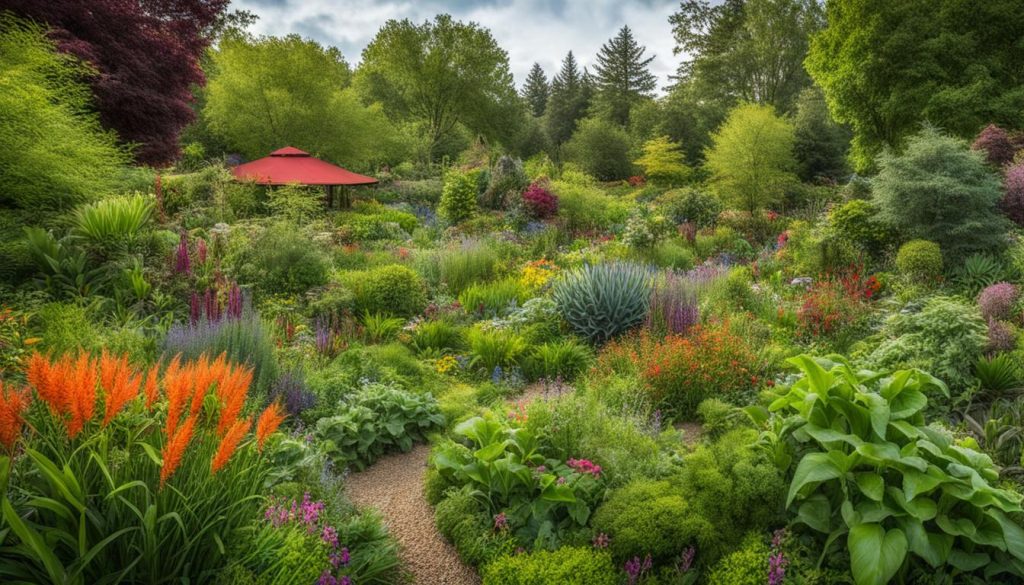
By following these simple guidelines, we can create a safe and welcoming environment for both ourselves and the wildlife around us. Remember, coexisting with wildlife is all about respect, understanding, and appreciation.
Maintaining Your Wildlife-Friendly Landscape
Creating a wildlife-friendly landscape is a rewarding endeavour, but it’s essential to maintain it to keep it thriving. In this section, we’ll provide tips for maintaining your wildlife-friendly landscape to ensure its long-term success.
Essential Maintenance Practices
Regular maintenance practices are essential to keep your wildlife habitat healthy and thriving. Here are some essential practices to keep in mind:
- Keep your yard clean and free of debris to reduce the risk of pests and disease.
- Regularly inspect plants for signs of damage or disease and take necessary action.
- Ensure that food and water sources are clean and regularly replenished.
- Remove invasive plant species to promote biodiversity and provide more space for native plants.
Seasonal Considerations
Wildlife-friendly landscaping requires ongoing attention throughout the year. Here are some seasonal considerations to keep in mind:
- Spring: Inspect plants and remove any winter debris. Prune shrubs and trees as necessary.
- Summer: Water plants during dry periods; avoid watering foliage to prevent fungal growth.
- Fall: Remove dead leaves and other debris to prevent pests and disease.
- Winter: Refill bird feeders and bird baths with fresh water. Provide shelter for wildlife to protect them from harsh weather conditions.
Adjusting Your Landscape to Cater to Wildlife
As your wildlife-friendly landscape evolves, it’s essential to make adjustments to cater to the changing needs of local wildlife. Here are some tips:
- Observe the behaviour of wildlife in your yard and adjust food and water sources accordingly.
- Add more shelter options if necessary, such as birdhouses or bat boxes.
- Consider adding a water feature, such as a small pond or bog garden, to attract more wildlife.
By incorporating these maintenance practices and adjustments, you can ensure that your wildlife-friendly landscape remains healthy and thriving for years to come.
If you have any questions, our team is always happy to help.
FAQ
What is wildlife-friendly landscaping?
Wildlife-friendly landscaping involves creating a habitat in your yard that supports local species. It focuses on providing food, water, shelter, and nesting spaces for wildlife, while using sustainable gardening practices.
Why should I consider wildlife-friendly landscaping?
Wildlife-friendly landscaping offers numerous benefits. It promotes biodiversity, supports pollinators, reduces water usage, and creates a unique and enjoyable backyard experience where you can observe and connect with nature.
How do I plan a wildlife-friendly garden?
Planning is essential for a successful wildlife-friendly garden. Consider factors such as the size and layout of your space, research native plants, create a variety of habitats, and ensure a balance between food sources, water features, and shelter.
Why are native plants important for wildlife habitat?
Native plants are crucial because they have evolved alongside local wildlife, providing the necessary food, shelter, and habitat. They are adapted to the region’s climate and soil conditions, making them more resilient and attractive to native species.
How can I provide food and water sources for wildlife?
You can attract wildlife by incorporating plants that produce berries, nectar, seeds, or fruits. Installing bird feeders, bird baths, and butterfly puddlers can also provide additional food and water sources to support local species.
What are some ways to create shelter and nesting spaces for wildlife?
You can create shelter and nesting spaces by planting trees, shrubs, and grasses that provide cover and refuge for wildlife. Brush piles, rock piles, and even birdhouses can also be utilized to offer a variety of habitats for different species.
How can I peacefully coexist with wildlife?
To peacefully coexist with wildlife, it’s important to respect their space and behaviors. Avoid feeding wildlife, secure garbage bins, and keep pets indoors or supervised. Creating safe zones and managing potential conflicts with humane methods are also important.
How do I maintain a wildlife-friendly landscape?
Regular maintenance is necessary to ensure the long-term success of your wildlife-friendly landscape. This includes pruning, weeding, and managing invasive species. Additionally, consider seasonal adjustments and staying informed about the evolving needs of local wildlife.

